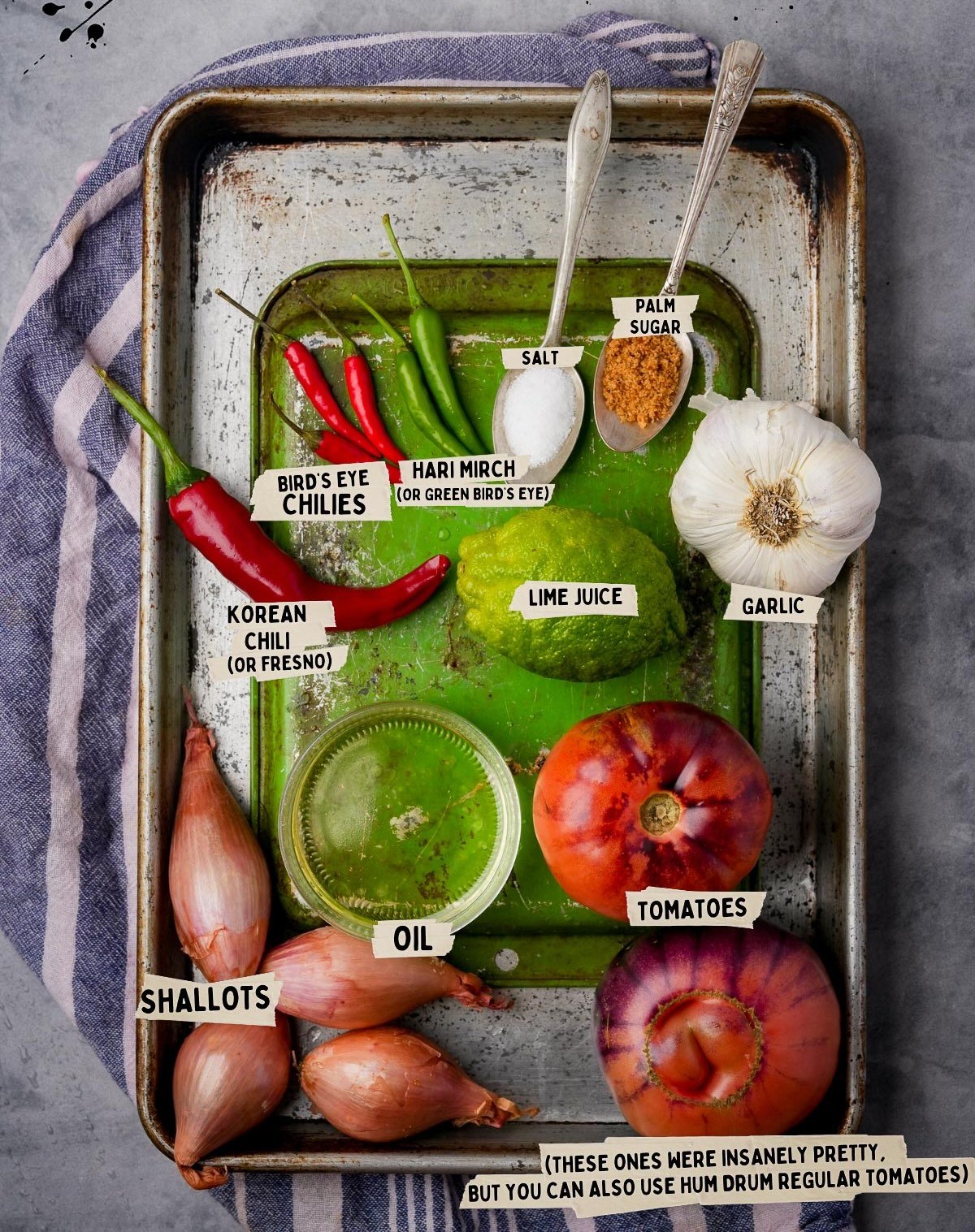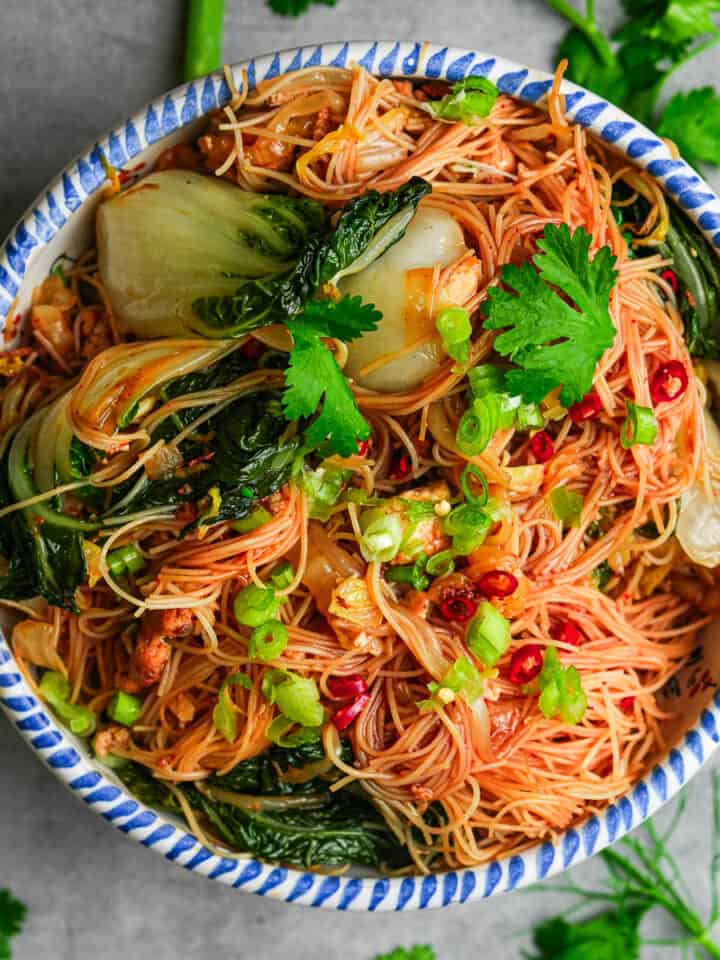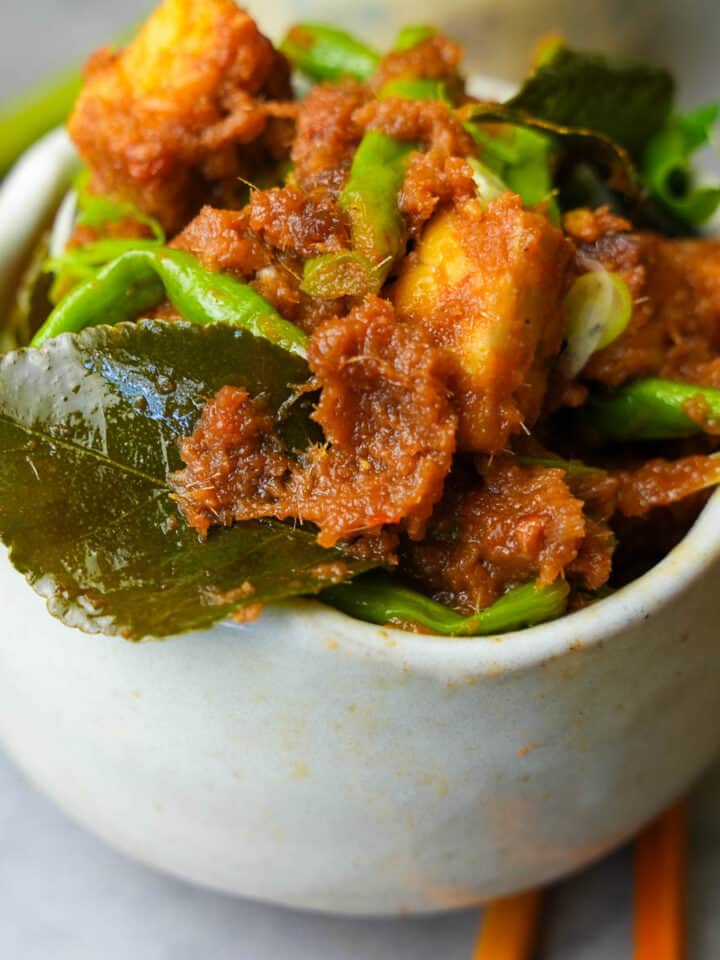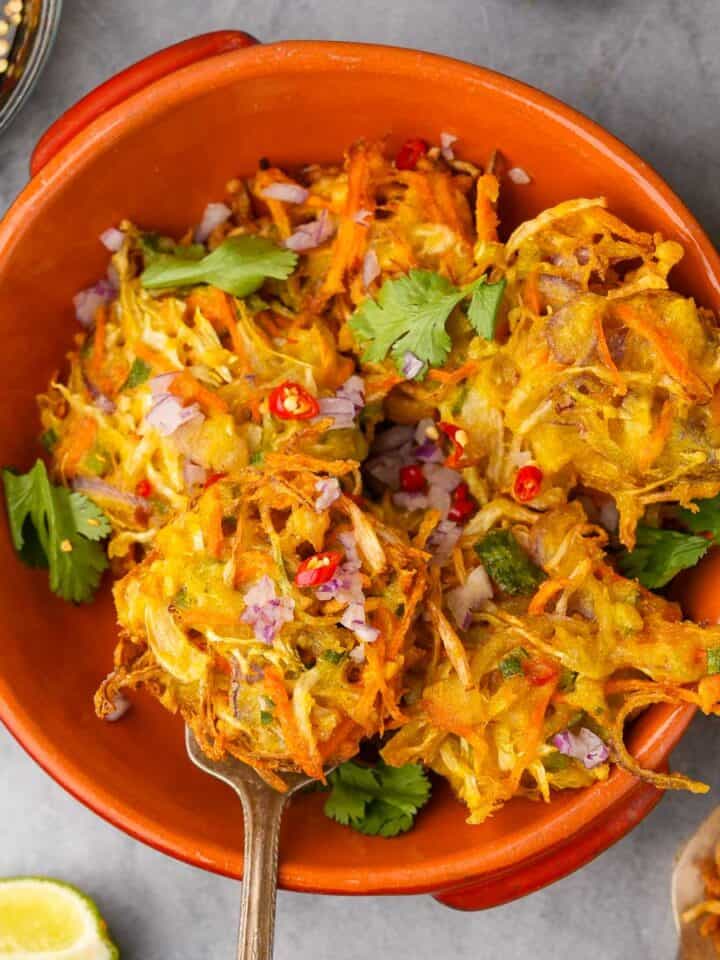*This post may contain affiliate links. Read more »
Sambal Dabu Dabu is a spicy, flavor-packed sambal that comes from the city of Manado, nestled in the North Sulawesi province of Indonesia.
The term “Sambal," is used loosely here, because normally that’s more of a chili paste, or chili sauce type of condiment. Dabu Dabu means mixing or crushing ingredients together. And that's precisely what we're about to do—combine an array of fresh, fiery components into a topping that will explode everything you put it on, from simple veggies grilled with gochujang marinade to Indonesian classics like Tahu goreng, urap sayur and lontong (banana leaf steamed rice cakes).


Enter your email & I'll send it to your inbox. Plus, get great new recipes from me every week!
By submitting this form, you consent to receive emails from Cinnamon Snail.
Traditionally served alongside grilled seafood or fish, its bright flavors offer a pungent, spicy contrast to the smoky, charred goodness of the grill. But for vegans like me and my family, we love it over char grilled tofu, or even as a topping to seitan bulgogi. Don’t let tradition limit your creativity with this freaking easy, flavor-bomb condiment!
I've distilled years of experience into these simple instructions to ensure that you nail Sambal Dabu Dabu on your very first attempt. Grab the freshest chilies and tomatoes you can get, put on your cutest apron, and let's create a masterpiece sambal that’s going to knock your senses into next Tuesday.
Jump to:
🥰Why you'll adore this dabu dabu sambal recipe
✊ Vegan AF: Like all of my Indonesian food and Malaysian recipes, this one is completely plant-based. No Terasi (shrimp paste) is gonna be found here! This also just happens to be gluten-free and soy-free.
🪄 Flavor Magic: The secret ingredient here? I like to use a mixture of three chilies- bird’s eye, hari mirch, and red Korean chilies. These three different peppers give even more spicy depth and dimension to the sambal. Don’t worry, I’ll also recommend substitutions in case you can’t find all three of those.
✅ Tested and Approved Worldwide: Like all the recipes on my blog, this Sambal Dabu Dabu has been meticulously tweaked to perfection and then tested by a large team of recipe testers in kitchens worldwide. You're in for a reliable, well-honed recipe that is a proven winner!


Warning: This Will Transform Your Vegan Indo Cooking!
This 6-day plant-based deep dive into the vibrant cuisine of Indonesia is 100% FREE.
🍅 Ingredients for sambal dabu dabu

Bird's Eye Chilies
Sometimes called “Thai chilies” abroad, in Indonesia they are called Cabe Rawit. These tiny powerhouses of heat originate from Southeast Asia and are the fiery backbone of everything from Burmese Khao Suey to Thai Tom Yum Paste. For a milder sambal, consider substituting with jalapeños or serrano peppers.
Hari Mirch
These small vibrant green chilies are prevalent in Indian food and bring heat to dishes like Punjabi okra, and chana masala. They make an insanely flavorful green chili pickle with a little bit of achar ka masala. They provide a pleasant, flavorful heat that complements the fiery bird's eye chilies. In case you can't find them, green bird’s eye chilies, Anaheim peppers or jalapeño peppers can be great substitutes.
Korean Red Chili Pepper
These red chilies add a touch of sweetness and a bright red hue to our Sambal Dabu Dabu. They have a moderate heat level, making them accessible to a wide range of palates. That’s why in this recipe, where the other chilies are minced, these are just thinly sliced. If you can't find them, Fresno chilies or a red bell pepper can be used for color and a mild kick.
Shallots
Shallots, or bawang merah in Indonesian, provide a sweet and mild onion-like flavor to the sambal. But you know what’s not mild about them? They make me cry worse than any type of onion I ever deal with. For real, once I worked at a restaurant that would regularly have me peel and slice a 50 lb. gag of these suckers, and it was a nightmare. Anyway, If you're out of shallots, or prefer to cry a little less, red onions can serve as a suitable substitute.
*See the recipe card at the bottom of the page for exact quantities, nutritional info, and detailed cooking directions.
🤯Variations
Mango sambal dabu dabu
Add ⅓ cup of diced green mango (raw mango) to your Sambal Dabu Dabu. I’m not talking about ripe sweet mango, and talking about the slightly hard tangy kind like you would use for making mango pickle, or Vietnamese rice paper salad. Trust me, this is a dope addition!
Makrut Lime sambal
Another raw sambal I love is called sambal matah. In place of the tomatoes, this sambal uses makrut (aka kaffir lime) and lemongrass to give it a more citrusy vibe. It’s less spicy, but just freakin’ lovely!
📖 How to make this sambal dabu dabu recipe
Nail this perfectly on your first shot by following these step-by-step instructions with important tips. Or you can follow along with the easy-to-print recipe card towards the bottom of this page.

Step One
Prep the Ingredients:
Finely chop bird's eye chilies, Korean chili (or fresno chili), green chilies, garlic, shallots, and tomato.

Step Two
Mix and Season:
In a mixing bowl, mix the prepared veggies with salt (to taste) and palm sugar, or a sweetener of your choice.

Step Three
Heat the Oil:
Heat cooking oil in a saucepan on high for 90 seconds. Once the oil is hot, drizzle it over the seasoned vegetables.

Step Four
Zesty Finish:
Stir in freshly squeezed lime juice and serve over everything from roasted eggplant to vegan fried chicken or just eat 5 lbs. of it straight out of an old hat, because you are wild as heck.
💡Serving Ideas
This sambal is absolutely legendary on your favorite grilled veggies or homemade seitan for a burst of Indonesian flavor.
Serve it alongside Sayer Lodeh, Sambal Goreng Tempeh, over Nasi Kunyit, Nasi Minyak, or Nasi Uduk Betawi.
It goes great as an added fresh dimension to Indonesian salads like Asinan Jakarta.
Take your favey noodle dishes to the next level by topping them with Sambal Dabu Dabu. Whether it's Bami Goreng, Ketoprak, Mee Rebus, Mie Goreng, or even Pad Woon Sen, a dollop of this sambal adds a spicy and tangy kick.
🍩 Don't forget about dessert!
Don’t leave the table with onion-breath! Smash a dessert afterwards like Kuih Dadar, Klepon, Bubur Cha Cha, Martabak Manis, or Biji Salak so you can kiss people without them falling over dead from your shallot-stank. Just kidding. Or am I?

👉Top tips for perfect sambal dabu dabu
- Balancing the Heat: Managing the spiciness is key. Adjust the number of bird's eye chilies to YOUR heat tolerance. It's easier to add more heat later than to tone it down once it's in the mix.
- Fine Chopping: Ensure your vegetables are finely chopped. Especially the shallots should be as thin as possible so that the juices from the tomatoes and hot oil penetrate them a little and soften their bite.
- Lime Juice Finish: The hot oil will do a better job par-cooking the ingredients if there is less liquid in the bowl. That’s why I recommend adding the lime juice just at the very end.
🤷♀️FAQ
Sambal Dabu Dabu is known for its spiciness, but you can adjust the heat by controlling the number of bird's eye chilies and other peppers you use.
Store it in an airtight container in the refrigerator, and it will stay fresh for up to three days.
It's not recommended to freeze this sambal as it’s freshness is key. The tomatoes and everything will take on a sorta terrible texture when thawed.
Over time, the tomatoes in the sambal may release some extra water. Before serving, you can simply drain off any excess liquid. After draining, taste the sambal and adjust with a pinch of extra salt or lime juice if needed to maintain the desired balance of flavors.
💣Bomb dishes to serve sambal dabu dabu all over:

Sambal Dabu Dabu (Indonesian spicy raw sambal from Manado)
Ingredients
- 3 bird’s eye chillies minced
- 1 Korean chili or Fresno chili, thinly sliced
- 2 green chilies hari mirch, thinly sliced
- 1 clove garlic minced
- 4 shallots thinly sliced
- 1 cup tomato diced
- ½ teaspoon salt or to taste
- 1 teaspoon palm sugar brown sugar, or coconut sugar
- 3 tablespoons oil canola, vegetable or sunflower
- 4 teaspoons lime juice
Instructions
- Begin by finely chopping the bird's eye chillies, Korean chili (or fresno chili), green chilies, garlic, shallots, and tomato.
- In a mixing bowl, combine the prepared vegetables with the salt (adjusted to your preference), and sugar.
- Heat the cooking oil in a saucepan over high heat for 90 seconds.
- When the oil is hot, pour it over the seasoned vegetables.
- Stir in fresh squeezed lime juice.
- Serve fresh or pack in an airtight container to use within two days.
Notes

Enter your email & I'll send it to your inbox. Plus, get great new recipes from me every week!
By submitting this form, you consent to receive emails from Cinnamon Snail.











Leave a Reply